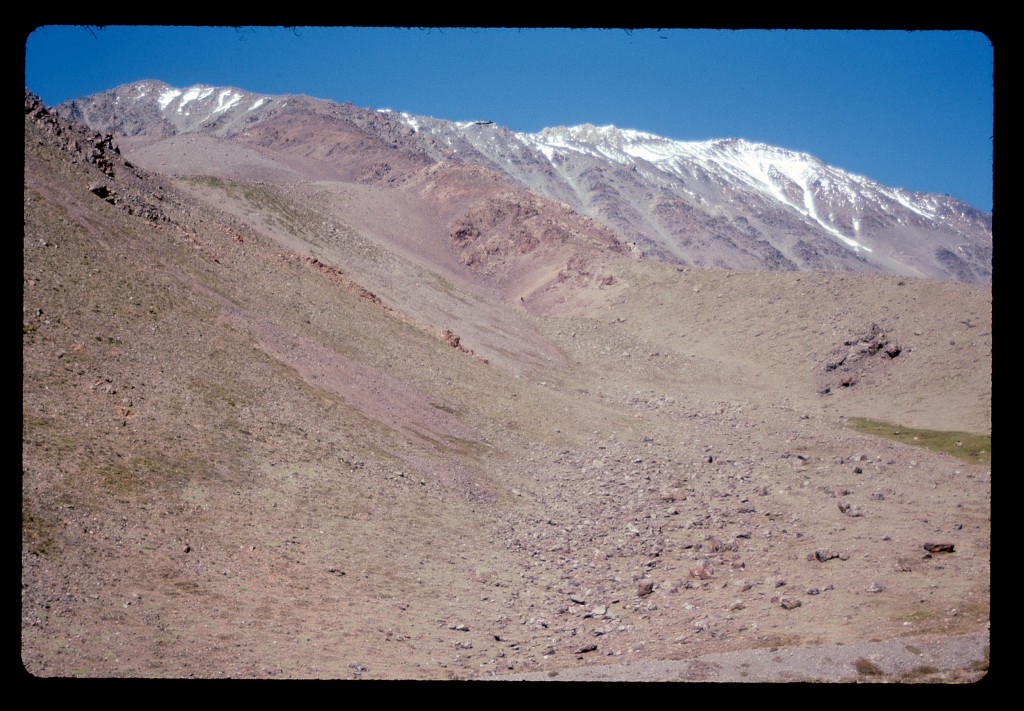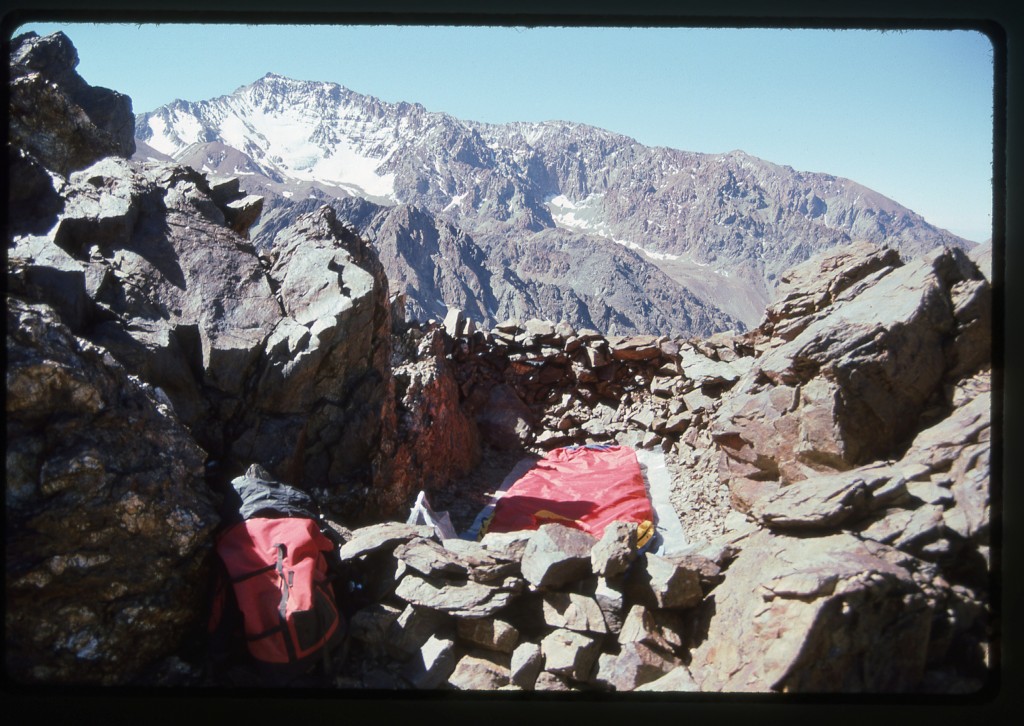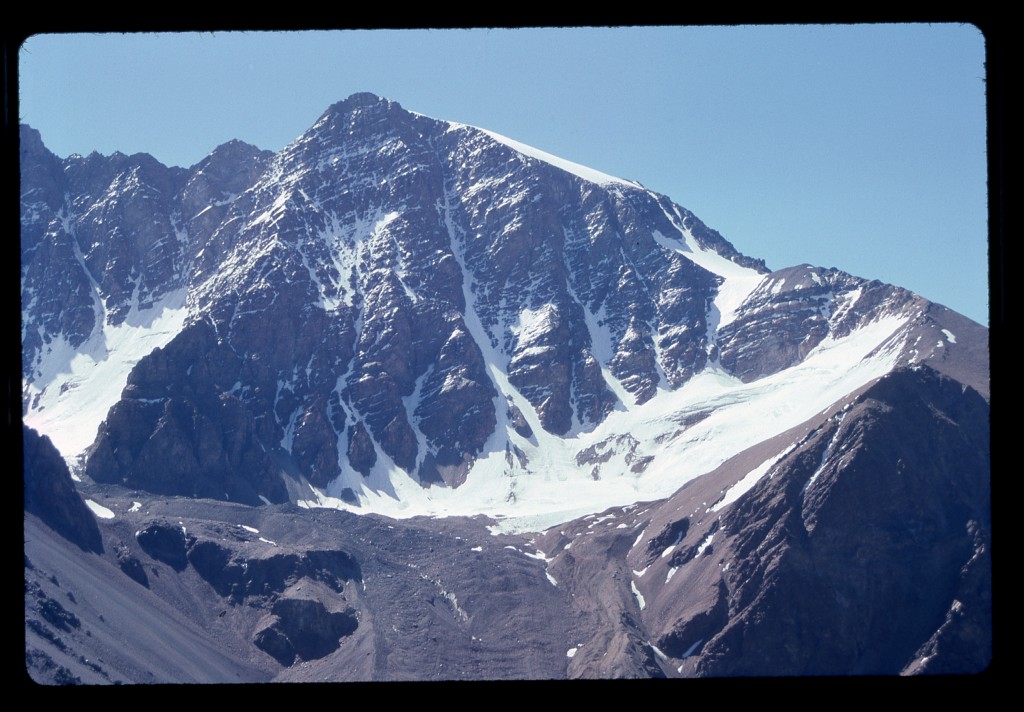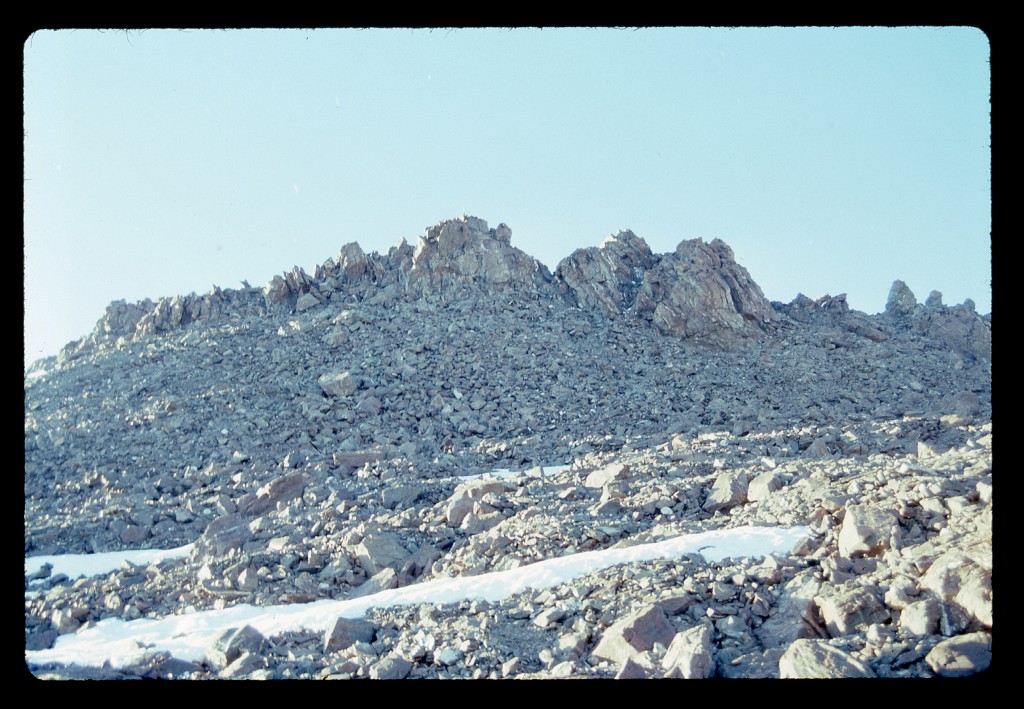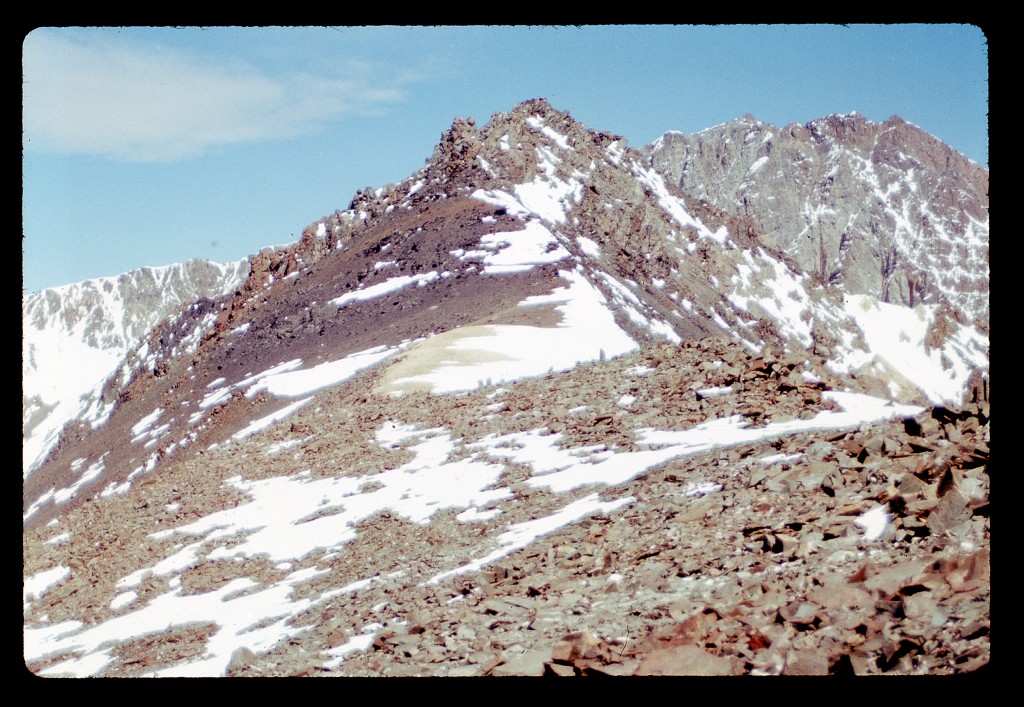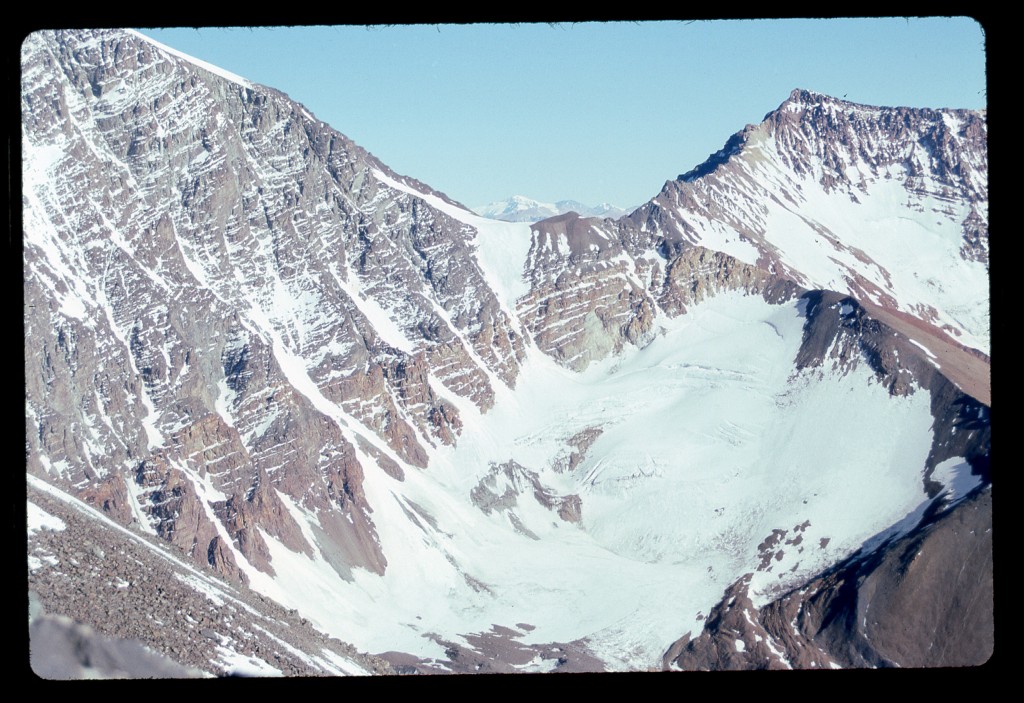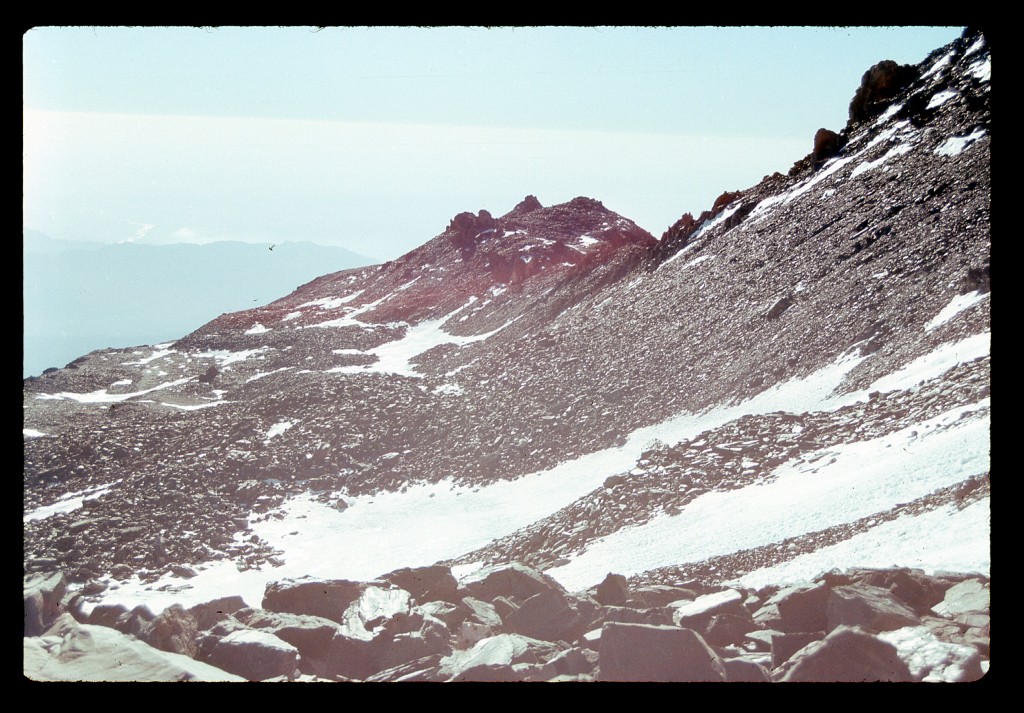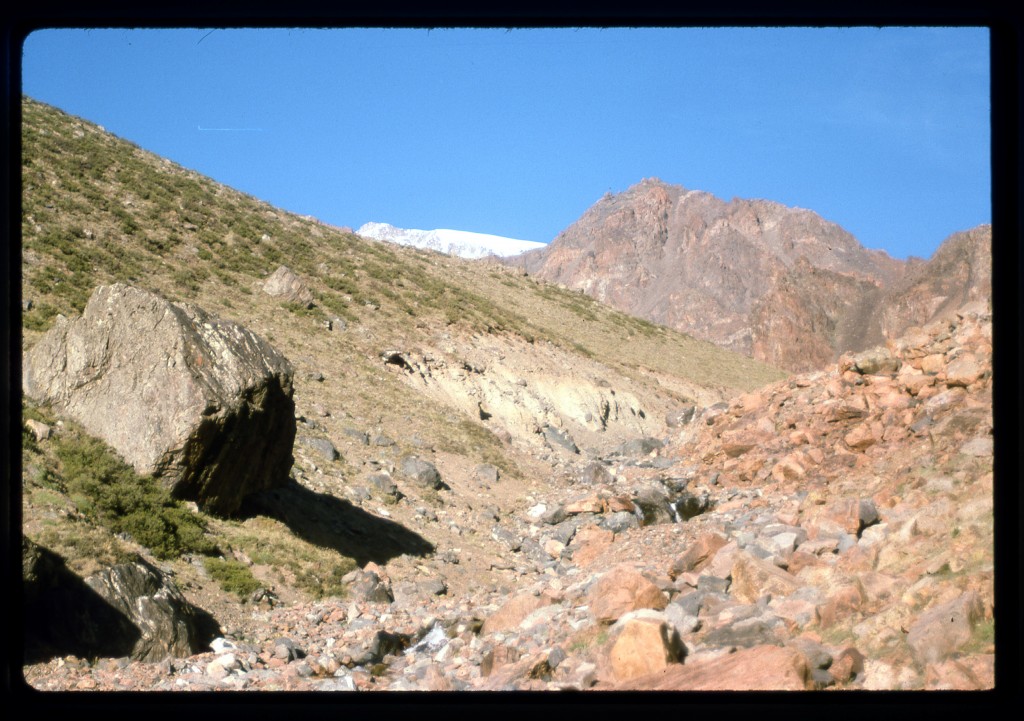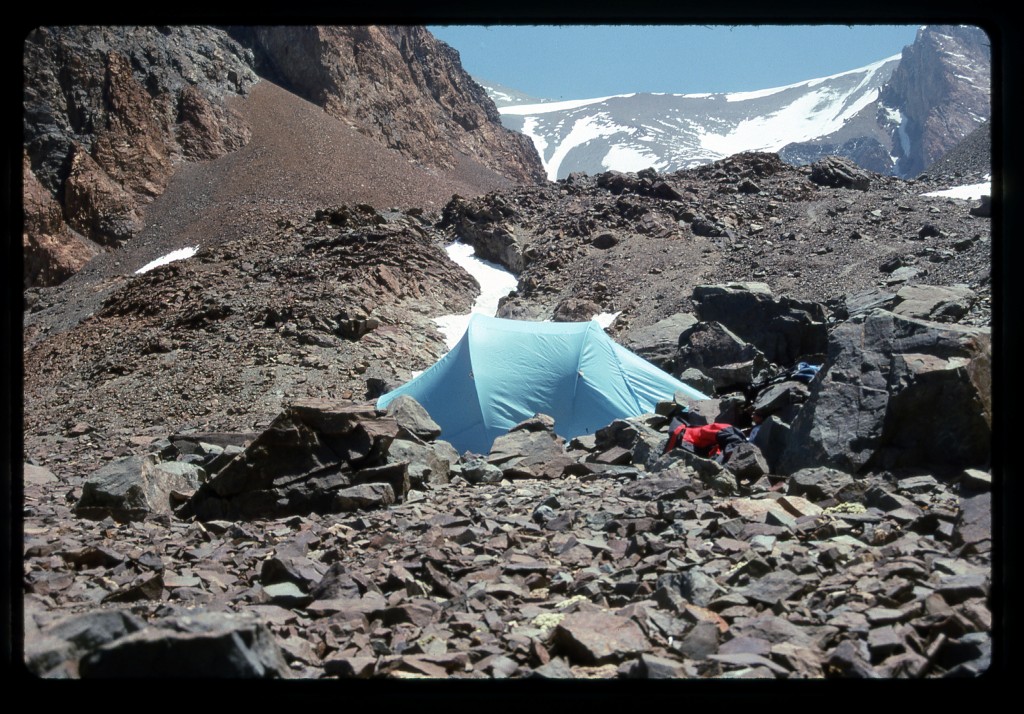To get the most from this story, please read the 3 prior installments (parts 1,2,3) which have already been published on this website.
After the best night’s sleep of the entire trip, I woke up late. Leaving the tent behind, I packed up everything else I’d need for a bivouac. Since I was the only one staying in the bunkhouse at the time, I locked it up and gave the key to Jorge. He fed me breakfast and, as we chatted, 30 soldiers arrived. They off-loaded some mules from trailers and said that in another day or two they’d head off to climb Cerro Plata. Man, the ski lodge was like Grand Central Station!
I headed out with full pack, the first time in eight days I’d done so. The trail up to La Vega went along a nice creek, where I filled up with four liters of icy water. By 11:30, I’d reached the base of the ridge descending from Cerro Franke – the day was still nice and clear.
I kept climbing, but put on my jacket at 12,000 feet, where I found a good flat campsite, the first of several I’d pass. Not wanting to stop any lower than necessary, I forced myself to keep going. At 3:30 PM, I found the perfect bivi site at 15,100 feet and called it a day.
I felt good. There wasn’t a cloud in sight – in fact, it was the first time on the trip when I had such perfect weather – usually clouds would build up in the afternoon. There was a rock wall around the bivi site – I spent some time building it up to a height of three feet on the downhill side.
The one luxury I’d brought with me to Argentina was a tiny AM-FM radio with headphones, and it proved a welcome companion on these lonely nights. Here, Mendoza and San Juan stations came in well. The lights of Mendoza filled a wide swath of the horizon 35 air miles away. It was cold enough tonight that I slept with my balaclava pulled down and covering my mouth. I hadn’t done that on Aconcagua and had developed a throat infection, so this trip I’d take no chances.
It was hard to crawl out of that sleeping bag, but I forced myself to do it and was moving by headlamp at 4:30 AM. The terrain was easy. First light was at 5:30, with sunrise at 6:15. By 7:00, I stood on the top of Cerro Franke, at 16,733′.
It was very cold and windy. I dropped down to a sort of plateau, where I crossed several small snowfields. Then I made my first mistake of the day – I chose the worst possible route to my next peak. Instead of staying up high on the ridge, I opted to drop down to avoid the icy blast, side-hilling on the north side. It took 3 1/2 grueling hours of steep snow, loose scree and rotten rock to put myself on the summit of Lomas Amarillas at 17,389′.
I sat a while enjoying the fruits of my labors – this was the highest point of my trip so far, and I felt pretty good. Here’s my view to the west, which interested me a lot because I knew I’d be there in a few days to climb even higher peaks.
When it came time to leave, I followed the ridge between my two peaks – much better – there was a lot of wet snow, but it was quick and pretty easy.
Then I made my second mistake of the day. Instead of staying on the ridge, I bailed too soon, thinking I’d traverse diagonally down to my bivi site. Sure, it worked, but I had to cut across about a zillion gritty gullies – what a freakin’ nightmare, and one entirely of my own making. The smart move would have been to have gone all the way back to the top of the ridge I’d ascended from my bivi site, then have an easy descent from there. But did I do that? Nooooo, and I paid the price. It took me until 2:20 PM to reach my gear, and the day spent at this height had finally caught up to me – I felt nauseous. Some antacids helped. I packed up my gear and continued down the scree slopes until I hit the trail in the valley below. Damn, my boots were starting to come apart again!
High clouds moved in quickly during the afternoon. The lower I went, the better I felt – by the time I got back to the lodge, I was right with the world once again. The past two days, I had climbed a total of 8,000 vertical feet above the lodge, and was feeling like I could now venture even higher.
I’d now been here six days, and it was even becoming easier to get along with Rambo. It was a good place to hang out, and a convivial bunch of guys made it easy to pass the time. It was tempting to just hang out here and drink wine, but I had a lot of climbing to do. That evening, I got to talking with some of the soldiers who were still there, a nice group of lads. After much wine, their young teniente cornered me and, on the QT, told me that at 6:00 AM the next morning they could carry me and my gear on mules all the way up to the camp at El Salto. What a lucky break!! I had been dreading that 5,300-foot carry with full pack. It seems they were going up with a mule train to retrieve gear from their group of 30 who had been out practicing something or other at high altitude.
I spent the evening packing my gear. A large group of 13, most of whom I’d met on that trip 11 days ago, arrived. Jorge sent them over to my bunkhouse to say hello. We got caught up over more good Mendozan wine. At 11:00 PM, Jorge invited me to supper with him and Rambo – the Argentines stay up outrageously late – but for once I politely declined, as I thought it’d be wise to get some sleep in anticipation of that early start.
I awoke at 4:30, was all set to leave by 6:00, but the soldiers slept in and we didn’t leave until after 8:00. I had a good mule on which to ride – another was tethered to mine with all my gear. I’m bringing everything but the kitchen sink, as I’m planning to be out for four days. Our train travels for three hours, covering far more distance than anyone could on foot. As we climbed steep sections of the trail, I could feel the mule’s heart pounding in its chest as it labored uphill. As strong as these gentle beasts were, even they had to stop from time to time for a brief rest.
When we were still over a thousand feet below the campsite at El Salto, the soldiers spotted some of their buddies up above, waiting for them. Since they weren’t supposed to be offering civilians free rides into the mountains on government mules, the entire mule train came to a halt. They unceremoniously dumped me and my gear in the middle of the trail and carried on without me. There was nothing for it but to shoulder my huge pack and stagger up the trail – now I knew how the mules must feel!
During the hour it took me to climb that thousand feet, I met a lot of soldiers descending. Thirty of them had successfully summitted Cerro Plata the previous day. Then I heard a voice calling out to me from above, “El Canadiense!” It was a fellow I had met back in February on Aconcagua, Gustavo Santecchio. He worked for Andesport, and had carried my pack the last 2,000′ down to Plaza de Mulas, maybe because he’d felt sorry for me, but mostly because he was just plain good folks. He said we’d meet again soon on Aconcagua.
It felt good to drop that pack at El Salto, 15,185 feet. What a spot – it sits there, perched high above the valley I’d ascended. It’s right beside the trail, so I knew there’d be plenty of folks coming by.
I pitched my tent, ate a big meal and then decided to go for a walk farther up the valley. When I reached a campsite called Ollada at 16,000′, I found six more soldiers camped there. They too had climbed Plata the day before. They, as well as others I’d met that day, told me I did not need crampons, ice ax or double boots for the summit. Hmmm, that got me thinking. Maybe they could take that gear down with them and leave it with Jorge at the ski lodge. That’d save me carrying that extra twelve pounds back down.
In 1990, it was almost impossible to get good climbing equipment in Argentina. In fact, there was a thriving market in used gear. At Plaza de Mulas, base camp for the ruta normal on Aconcagua, you could sell just about anything for a good price. So, it was a bit of a risk to just hand my stuff off to complete strangers in the hope they’d drop it off at the lodge. It didn’t hurt any that I dropped the lieutenant’s name, so I asked and they agreed. I left my gear in their capable hands and headed back down to my tent. Curled up in my sleeping bag, I took aspirin for a headache and wrote postcards to friends back home. Boy, do I need a bath – my legs are black from the caked-on dirt. Tomorrow, I’d climb higher yet. Bit by bit, I was working my way up to the highest reaches of the range. If this wasn’t building up my red-blood-cell count, then nothing would.

